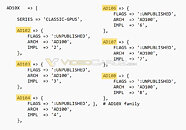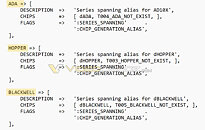- Joined
- Oct 9, 2007
- Messages
- 47,670 (7.43/day)
- Location
- Dublin, Ireland
| System Name | RBMK-1000 |
|---|---|
| Processor | AMD Ryzen 7 5700G |
| Motherboard | Gigabyte B550 AORUS Elite V2 |
| Cooling | DeepCool Gammax L240 V2 |
| Memory | 2x 16GB DDR4-3200 |
| Video Card(s) | Galax RTX 4070 Ti EX |
| Storage | Samsung 990 1TB |
| Display(s) | BenQ 1440p 60 Hz 27-inch |
| Case | Corsair Carbide 100R |
| Audio Device(s) | ASUS SupremeFX S1220A |
| Power Supply | Cooler Master MWE Gold 650W |
| Mouse | ASUS ROG Strix Impact |
| Keyboard | Gamdias Hermes E2 |
| Software | Windows 11 Pro |
The recent NVIDIA data-leak springs up information on various upcoming graphics parts. Besides "Ada Lovelace," "Hopper," we come across a new codename, "Blackwell." It turns out that NVIDIA is splitting the the graphics and compute architecture naming with the next generation, not unlike what AMD did, with its RDNA and CDNA series. The current "Ampere" architecture is being used both for compute and graphics, with the streaming multiprocessor for the two being slightly different—the compute "Ampere" has more FP64 and Tensor components, while the graphics "Ampere" does away with these in favor of RT cores and graphics-relevant components.
The graphics architecture to succeed GeForce "Ampere" will be GeForce "Ada Lovelace." GPUs in this series are identified in the leaked code as "AD102," "AD103," "AD104," "AD106," "AD107," and "AD10B," succeeding a similar numbering for parts with the "A" (GeForce Ampere) series. The compute architecture succeeding "Ampere" will be codenamed "Hopper." with parts in the series being codenamed "GH100" and "GH202." Another compute or datacenter architecture is "Blackwell," with parts being codenamed "GB100" and "GB102." From all accounts, NVIDIA is planning to launch the GeForce 40-series "Ada" graphics card lineup in the second half of 2022. The company is in need of a similar refresh for its compute product lineup, and could debut "Hopper" either toward the end of 2022 or next year. "Blackwell" could follow "Hopper."



View at TechPowerUp Main Site | Source
The graphics architecture to succeed GeForce "Ampere" will be GeForce "Ada Lovelace." GPUs in this series are identified in the leaked code as "AD102," "AD103," "AD104," "AD106," "AD107," and "AD10B," succeeding a similar numbering for parts with the "A" (GeForce Ampere) series. The compute architecture succeeding "Ampere" will be codenamed "Hopper." with parts in the series being codenamed "GH100" and "GH202." Another compute or datacenter architecture is "Blackwell," with parts being codenamed "GB100" and "GB102." From all accounts, NVIDIA is planning to launch the GeForce 40-series "Ada" graphics card lineup in the second half of 2022. The company is in need of a similar refresh for its compute product lineup, and could debut "Hopper" either toward the end of 2022 or next year. "Blackwell" could follow "Hopper."



View at TechPowerUp Main Site | Source



